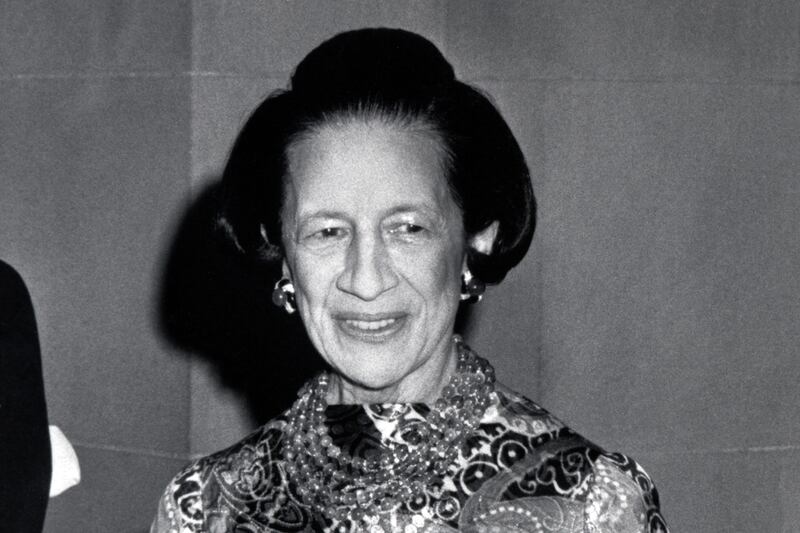
For anyone whose life is animated by the roiling winds of the fashion industry, the mere mention of the name Diana Vreeland resonates like a clap of thunder. During the middle of the last century, Vreeland served as a fashion editor at Harper’s Bazaar and then as the editor-in-chief of Vogue. Her tenure at Vogue, in particular, is remembered by fashion’s faithful as immeasurably influential in defining the role of a modern fashion boss lady and in expanding the creative capacity of the industry itself.
The mythic quality of Vreeland’s career was only enhanced when she was fired from Vogue in 1971, leaving behind her a trail of scandalously expensive editorial shoots—one of which was estimated to have cost $1 million—as well as a long line of assistants and colleagues who had been treated roughly but whose admiration for her was not in the least diminished.
In the twilight of Vreeland’s life, fretful about her financial well-being, she signed on as a consultant to the Costume Institute at the Metropolitan Museum of Art. Her exhibitions—on topics such as Balenciaga, Hollywood, and Yves Saint Laurent—proved to be blockbusters, even if many of the traditional rules of scholarly research had been conveniently jettisoned in favor of drama and accessibility.
ADVERTISEMENT
Vreeland’s professional successes turned her into a fashion legend—revered within the insular world of designers and editors as a soothsayer, a kingmaker, and a transformative figure. And her eccentric ways, such as her kabuki personal grooming and tendency to fill her work-a-day language with continental pronunciations and lyrical riddles, have maintained her status as an irresistible icon long after her death in 1989.
A significant artistic output has been dedicated to celebrating Vreeland. This year, her granddaughter-in-law, Lisa Immordino Vreeland, produced The Eye Has to Travel, a well-received documentary about the infamous editor. Before that, there was the stage play Full Gallop and Vreeland’s own memoir, D.V.
To understand Vreeland is to gain insight into the deeply embedded code of storytelling, eccentricity, commerciality, passion, and cruelty that define today’s fashion industry. But Vreeland was a profoundly cryptic and misdirecting woman. She told tall tales about her upbringing, ignored inconvenient facts and lived within her own dreams.
But a new biography by Amanda Mackenzie Stuart cuts through the fog of fashion. She dissects Vreeland’s life with the analytic fervor that might be reserved for a battle-weary general or a poet laureate. With Empress of Fashion: A Life of Diana Vreeland, Stuart does more than celebrate and bear witness. She seeks to explain, to parse, and to ultimately decipher the woman behind the strokes of red rouge and dyed-black hair.
The reality is this: from the beginning of Vreeland’s life, until the end, beauty was both misery and currency.
Every soul is a creature of their circumstances and Vreeland was the product of a distant and unkind mother, a charming father, a mean-spirited nanny, and a beloved beauty of a younger sister. Stuart quotes a telling exchange that Vreeland recalls having with her mother: “One day she said to me, ‘It’s too bad that you have such a beautiful sister and that you are so extremely ugly and so terribly jealous of her. This, of course, is why you are so impossible to deal with.’”
Contrary to one of Vreeland’s preferred embellishments, she did not arrive in this world to the sound of Berber ululations in the Atlas Mountains of North Africa. She was born in Paris on Sept. 29, 1903. Her father, Frederick Dalziel, was British and with a bearing and patter that suggested far more wealth than he had. Her mother, the former Emily Key Hoffman, was American and a southerner with a distant relationship to Francis Scott Key who composed “The Star Spangled Banner.”
Her parents left Paris for New York less than a year after Vreeland’s birth. In 1907, Vreeland’s sister Alexandra was born stateside. The family lived an upper-class life and thanks to Vreeland’s mother’s side of the tree, which had both wealth—through banking connections—and pedigree, they gained entry into a world of Astors and Vanderbilts.
While Vreeland defined herself by a Paris upbringing, much of her childhood was spent in New York. Stuart does a yeoman’s job in sorting through the fuzzy details of Vreeland’s younger years. She explores Vreeland’s teenage discomfort with her looks but she cautions against using that angst as a full and simple explanation for Vreeland’s attraction to an industry based on superficialities.
Stuart paints a young Vreeland as a creature of her time and social standing. She was expected to marry, which she did, to a young man named Reed Vreeland with whom she was passionately in love. But in one crucial way she subverted expectations: she worked. And this is the point at which her story becomes interesting.
Readers must have been patient and determined to have made it this far, for they will have waded through a bog of European nobility, endured mind-numbing trips to Newport and San Remo and patiently dealt with the obsessive decorating, shopping, and gala-going that defined the lives of the young socialites of the era. This is not necessarily a flaw on the part of the biographer but rather the reality that the young Mrs. Vreeland faced. Her life was glittering and glossy but with little to distinguish it from the other shiny lives of the day.
That changed when Carmel Snow, the editor-in-chief of Harper’s Bazaar, invited Vreeland to join the magazine. Snow had identified Vreeland as a woman of particular style. She would figure out what to do with Vreeland once she arrived at the publication
Vreeland’s career began as an unnerving—for her—lark. It evolved into a lifestyle. As it turned out, Reed Vreeland was not the most resourceful and ambitious man. Diana would ultimately be the main breadwinner for the family, which included the couple’s two sons.
For all of Vreeland’s devil-may-care attitude and progressive fashion viewpoint, she could be surprisingly traditional and near-sighted on other topics. She embraced hippie style, but had little use for the flower children themselves. She had an antagonistic relationship to feminists, seeing no advantage in their discussions of psychological malaise and gender inequality. And when she suspected that Reed was growing away from her and might leave her altogether, she practically forced his return by threatening to do herself in.
She could be wretchedly imprecise, capricious, and heartless to her co-workers. Her disinterest in the business concerns of magazines was extreme and ultimately self-destructive during her tenure at Vogue. Political correctness was not part of her vocabulary, but anti-Semitic verbiage was.
And in her final years, when she was blinded by macular degeneration and suffocating with emphysema, vanity left her isolated. She could no longer dye her hair the raven-black that had for so long been her signature, and so refused to greet visitors in person, talking to them from behind a door or a screen.
By the time she died of a heart attack in New York’s Lenox Hill hospital, a reader is left to ponder: Was fashion made better by this woman who encouraged American designers and women to dream? Or had her own fantasies and vanity left her trapped behind an impenetrable, isolating wall? The fact that a reader is moved to even ask the questions, suggests that Stuart paints a nuanced portrait of a strange and tantalizing woman.
Fashion may ultimately have benefited from Vreeland’s curious foibles and deep flaws. But it did not hide them—no matter how desperately Vreeland may have wished that were so.






